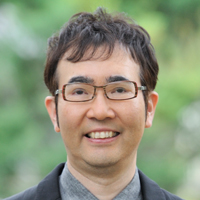Title of Presentation
“What is life? It is dynamic equilibrium.”
Dynamic equilibrium as a view of life
What is life? This is a question that human beings have always asked. How does current biology answer the question? In the middle of the 20th century, the double-helical structure of DNA was discovered. Two chains of DNA with a complementary structure exist as mirror images of each other, a finding that directly suggested replication and transmission of genetic information. As a result, biology has subsequently defined life as a “self-replicating system.” There was, however, another paradigm. Approximately ten years before the discovery of the structure of DNA, the physicist Erwin Schrödinger stated in his book “What is Life?” that highly organized living matter requires a special mechanism by which entropy accumulating in its system is always exported, in order to maintain life. Life might have been defined based on this view; however, even Schrödinger was unable to identify what the special mechanism is.
A further decade before the publication of Schrödinger’s book, the biochemist Rudolf Schoenheimer, who had been exiled from Germany to the United States, thought of a revolutionary idea: isotope-labeled nutrients may help to visualize metabolism in a living body. This experiment produced surprising results. All components of the body are continuously degraded and synthesized and replaced by components of nutrients. Nutrients are not just fuel. Schoenheimer revealed that life exists in a state of flux. He called it a “dynamic state” of life; however, the phrase “dynamic equilibrium” may be more suitable because synthesis and degradation are in the right equilibrium, in which degradation always occurs before new synthesis. In addition, active degradation is equivalent to the special mechanism for exporting entropy that was predicted by Schrödinger. From the late 20th century to the 21st century, biology has continuously revealed that living matter destroys itself more actively than it creates itself, as if Schrödinger’s prediction was embodied. All research into the ubiquitin system, the proteasome, and autophagy is based on this second paradigm that is descended from Schoenheimer and Schrödinger, namely a view of life as a dynamic equilibrium. Therefore, the question “What is life?” can be answered by stating “It is dynamic equilibrium.”
Profile
- Web Site URL
- https://shinichi-fukuoka.themedia.jp/
- A brief Biography
-
Shin-Ichi Fukuoka, Ph.D., is a biologist born in Tokyo in 1959. After he graduated from Kyoto University, he pursued a career that included a postdoctoral fellowship at Harvard Medical School, USA, and an associate professorship at Kyoto University. Currently, he is serving as a Professor at Aoyama Gakuin University and a visiting professor at the Rockefeller University, USA. He has published many books that again raise the question “What is life?” based on the idea of dynamic equilibrium, including his bestselling book “Between organic and inorganic matter (Kodansha’s new library of knowledge)” that sold more than 800,000 copies and was awarded the Suntory Prize for Social Sciences and Humanities and “Dynamic equilibrium (Kirakusha, Inc.).” His books with other themes include “No borders in the world (Kodansha’s new library of knowledge),” “Misbegotten men (Kobunsha Shinsho),” “Counterattack of life (Asahi Shimbun Publications Inc.),” “Tale of life (Shinchosha Publishing Co., Ltd.),” “Keep changing to prevent changing (Bungeishunju Ltd.),” and “Bookshelf of Dr. Fukuoka (Media Factory).” His conversations with interviewers are described in “Dynamic equilibrium dialogue (Kirakusha, Inc.)” and “Looking for a sense of wonder (Daiwa Bunko).” He also published translated books in Japanese, such as “The Voyages of Doctor Dolittle (Shinchosha Publishing Co., Ltd.)” and “The human body shop: the engineering and marketing of life (Kodansha’s new library of knowledge).” His recent publications are “Dynamic equilibrium: new edition (Shogakukan Shinsho)” and “Shin-Ichi Fukuoka reads Nishida’s philosophy: a journey of thoughts over life; dynamic equilibrium and the absolutely contradictory self-identity (Akashi Shoten).” In December 2017, he published the latest book in his series, “Dynamic equilibrium 3 (Kirakusha, Inc.),” after an interval of six years.
He is also known as a huge fan of Vermeer. He traveled around the world to see all of Vermeer’s works and wrote about his journey in “Vermeer: Realm of Light (Kirakusha, Inc.).” He and his co-author Yuriko Kuchiki also published “Over-interpretation of Vermeer (Asahi Shinsho).” In addition, he served as the Supervisor and Director of the “Vermeer Center Ginza” in which all of Vermeer’s works were exhibited, recreated by state-of-the-art digital printing technology.
In November 2015, he established “Schola Sapientia by Shin-Ichi Fukuoka” to question anew how we should read books, and has served as the principal. - Details of selected Awards and Honors
-
2006 First Science Journalist Award 2006 Kodansha Science Publication Award of Publishing Culture Awards 2006 for “Is the prion theory true?” 2007 29th Suntory Prize for Social Sciences and Humanities (Life and Society) for “Between organic and inorganic matter” 2008 First Shinsho Award for “Between organic and inorganic matter” - A list of selected Publications
-
“Between organic and inorganic matter” (Kodansha’s new library of knowledge)
“Dynamic equilibrium” (Kirakusha, Inc.)
“Vermeer: Realm of Light” (Kirakusha, Inc.)
“Misbegotten men” (Kobunsha Shinsho)
“Counterattack of life” (Asahi Shimbun Publications Inc.)
“Tale of life” (Shinchosha Publishing Co., Ltd.)
“Keep changing to prevent changing” (Bungeishunju Ltd.)
“Bookshelf of Dr. Fukuoka” (Media Factory)
“Shin-Ichi Fukuoka reads Nishida’s philosophy: a journey of thoughts over life; dynamic equilibrium and the absolutely contradictory self-identity” (Akashi Shoten)
Hase K, et.al. Uptake through glycoprotein 2 of FimH(+) bacteria by M cells initiates mucosal immune response. Nature 462, 226-30 (2009)






